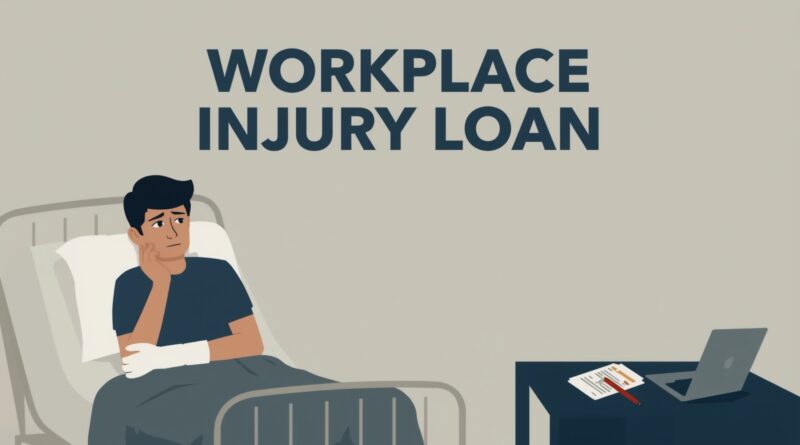Workplace Injury Loan: Financial Support When You Need It
Suffering a workplace injury can change your life. It affects your health and your money. Medical costs add up, and not working can hurt your finances a lot.

A workplace injury loan offers financial help during tough times. It’s made to cover your costs while you heal from your injuries.
This article will explain how workplace injury loans work. We’ll look at their benefits and why they’re important. Knowing your financial options can help a lot in your recovery.
What Happens Financially After a Workplace Injury
Getting hurt at work can really hurt your wallet. You might face unexpected medical bills and lost income. This can affect many parts of your life.
Immediate Medical Expenses
Right after an injury, you’ll start to see medical bills pile up. Costs for hospital stays, surgeries, and rehab can be huge. These bills can be a big financial hit.
Lost Wages and Income Disruption
Workplace injuries also mean lost wages. Time off for recovery can mess up your finances. It’s hard to keep up with bills like rent, utilities, and food.
Long-term Financial Consequences
The effects of a workplace injury don’t stop after the initial shock. You might need ongoing medical care, face permanent disability, or earn less. These issues can impact your finances for a long time.

A workplace accident loan can help during tough times. It’s important to understand the financial impact of an injury. This way, you can find the right financial help.
What Is a Workplace Injury Loan?
A workplace injury loan helps people who got hurt at work. It covers costs like medical bills and living expenses while they wait for their claim to be settled.
Definition and Basic Concept
A workplace injury loan, or injury settlement loan, is financial help for those waiting on workers’ compensation claims. It’s not a regular loan because you only pay it back if your claim is successful.
How These Loans Differ from Traditional Loans
Workplace injury loans don’t check your credit or income. They’re based on the potential settlement from your claim. If you don’t win your claim, you don’t have to pay back the loan, making it a no win no fee deal.

The Legal Basis for Injury Funding
Workplace injury loans are based on workers’ compensation laws, which vary by state. These laws help injured workers financially. The funding comes from companies that have a stake in the claim’s outcome.
Important things about workplace injury loans include:
- No upfront costs or fees
- Repayment is contingent upon the success of the claim
- No credit checks or income verification required
- Funding is provided by specialized companies with expertise in workers’ compensation claims
Types of Workplace Injury Loans Available in the U.S.
After a workplace injury, it’s key to know about different loan options. In the U.S., there are many loans to help workers while they recover.
Pre-settlement Funding
Pre-settlement funding gives financial help to injured workers before their case settles. It’s based on the expected settlement and helps with immediate costs.
Post-settlement Funding
Post-settlement funding is for after a case settles. It lets people get part of their settlement early. This helps with financial needs while waiting for the full settlement.
Workers’ Compensation Loans
A workers compensation loan is for employees with work-related injuries. These loans offer financial support while workers’ compensation claims are being processed.
Personal Injury Loans
Personal injury loans help those dealing with injury aftermath. They cover various costs, like medical bills and living expenses.
| Loan Type | Description | Timing |
|---|---|---|
| Pre-settlement Funding | Financial assistance based on expected settlement | Before settlement |
| Post-settlement Funding | Early access to settlement funds | After settlement |
| Workers’ Compensation Loans | Support during workers’ compensation claims processing | During claims processing |
| Personal Injury Loans | Financial assistance for injury-related expenses | Varies |

Knowing about these loan options can help injured workers make better financial choices. Each loan has its own benefits and should be considered based on individual needs.
When to Consider a Workplace Injury Loan
Workplace injuries can cause a lot of financial stress. It’s important to know when to get a loan for workplace injury claims. There are different situations where you might need a loan to handle your money well.
Delayed Workers’ Compensation Benefits
If you’re waiting too long for workers’ compensation, a loan can help. It covers your immediate costs. Waiting too long can make it tough to pay for everyday things.
Insufficient Insurance Coverage
If your insurance doesn’t cover all your medical and lost wages, a loan can help. It makes sure you can pay your bills without too much trouble.
Ongoing Legal Proceedings
Legal fights over your injury can be long and costly. A loan can give you financial peace of mind. It helps you pay for things while you’re in court.
Essential Living Expenses
It’s key to keep up with your basic needs. A workplace injury loan can help you do that. It ensures you can still afford the essentials, even with injury costs.
Knowing when to get a workplace injury loan can really help your finances. It’s about making smart choices to manage your money when things get tough.
Eligibility Requirements for Injury Settlement Loans
To get a workplace injury loan, you need to meet certain criteria. These loans help people waiting for their workplace injury claims to be settled. You must have a valid claim, legal help, and a strong case to qualify.
Valid Workplace Injury Claim
A valid claim is key to getting an injury settlement loan. You must have been hurt at work and have a claim against your employer or someone else. Your claim should be ongoing, with legal steps either started or about to start.
Legal Representation Requirements
Having a lawyer is usually a must. You need a lawyer who is working on your workplace injury claim. They help by providing important documents and insights into your case’s chances.
Case Strength Assessment Criteria
The strength of your case matters a lot. Lenders look at how likely you are to win or get a settlement. They consider how bad the injury is, who is at fault, and how much you might get.
State-Specific Eligibility Factors
State laws can also play a part. Some states have rules about loans for lawsuits. These rules can change how likely you are to get a loan.
Knowing what you need to qualify is important if you’re thinking about a workplace injury loan. Meeting these requirements can help you get the financial support you need while your claim is being processed.
The Application Process for Workplace Injury Loans
To get a workers compensation loan, you need to follow a few steps. First, you gather the needed documents. Then, you talk to loan providers. This makes it easy for injured workers to get the financial help they need.
Required Documentation
The first step is to collect the right documents. You’ll need:
- Medical Records: Proof of your injury and treatment.
- Legal Case Information: Details about your claim and any legal actions.
- Employment Verification: Proof that you were working when you got hurt.
Medical Records
Medical records are key. They show your injury and treatment. This helps lenders see if your claim is valid and worth something.
Legal Case Information
It’s also important to share your legal case details. This tells lenders about your claim’s context and possible outcome.
Employment Verification
Confirming your employment is vital. It proves the injury happened at work. You can use payroll records or a letter from your employer.
Consultation with Loan Providers
After you have your documents, talk to loan providers. Discuss your case and the loan terms. This helps you understand what you’re getting into.
Approval Timeline and Expectations
The approval process involves reviewing your documents and assessing your case. It usually takes a few days. Knowing when to expect approval helps you plan your finances better.
Costs and Interest Rates of Workplace Accident Loans
Workplace accident loans can be a big help for those hurt at work. But, their costs and interest rates can be tricky. It’s key to understand these financial details to make smart choices.
Typical Fee Structures in the Industry
Loan providers for workplace accidents usually charge fees that differ a lot. These fees are often a part of the loan amount. They can be from 10% to 50% or more, based on the case’s complexity and the lender’s rules.
Compound vs. Simple Interest Considerations
Workplace accident loans can have simple or compound interest. Simple interest is just on the loan amount. Compound interest adds interest on both the loan and any interest already earned. Knowing your loan’s interest type is key to figuring out the total cost.
How Rates Vary Based on Case Strength
The strength of your case affects the interest rates and fees you get. Lenders look at how likely your claim is to succeed and adjust rates. A stronger case usually means better terms.
Hidden Fees to Watch For
There might be extra costs with workplace accident loans, besides the interest rates and fees. These can include application fees, processing fees, and more. It’s important to check the loan agreement well to spot any hidden fees.
| Fee Type | Average Cost | Description |
|---|---|---|
| Application Fee | $100-$500 | Initial fee for processing the loan application |
| Interest Rate | 10%-50% | Rate applied to the loan amount, can be simple or compound |
| Processing Fee | $50-$200 | Ongoing fee for managing the loan |
Knowing the costs and interest rates of workplace accident loans helps injured workers make better choices. It’s vital to read the loan terms carefully and ask questions if unsure.
Benefits of No Win No Fee Loans for Injured Workers
No win no fee loans are a big help for workers hurt on the job. They offer financial support during tough times. This way, injured workers can pay their bills without worrying about legal fees first.
Risk-Free Financing Structure
One key benefit is the no risk loan setup. If the worker loses their case, they don’t have to pay back the loan. This means no financial risk when fighting for justice.
No Credit Check Requirements
No credit checks are needed for these loans. This makes them available to people who might not get loans because of bad credit.
Non-Recourse Funding Advantages
These loans are non-recourse funding. This means you only pay back if you win your case. It’s a big plus for workers, as it makes the lender and borrower work together.
Fast Access to Needed Funds
No win no fee loans give quick access to money. They help injured workers pay for medical bills and living costs while their case is being decided.
- Quick financial relief
- No upfront costs
- Alignment of lender and borrower interests
Potential Drawbacks and Risks to Consider
Getting a workplace injury loan is a big decision. It’s important to think about both the good and the bad sides. These loans can help when you’re down, but there are risks to watch out for.
High Interest Rates and Costs
One major worry with a loan for workplace injury claim is the high interest rates. These can cut down a lot on what you get from your settlement.
Impact on Settlement Negotiations
Also, taking a workplace injury loan can affect how you negotiate your settlement. The lender might have a say in the talks.
Regulatory Considerations by State
It’s key to know the laws in your state about workplace injury loans. They can change a lot from one place to another.
Ethical Considerations
Finally, think about the ethics. Make sure you’re working with lenders who are fair and honest.
In short, while a workplace injury loan can be a big help, it’s vital to weigh the downsides and risks carefully.
How to Choose the Right Workplace Injury Loan Provider
Finding the right workplace injury loan provider is important. It helps cover medical costs and keeps your job. Think about several key factors when looking.
Researching Reputable Companies
First, look for companies that offer injury and workers compensation loans. Choose ones with a good reputation and history of helping clients. Reliable companies are open and communicate well.
Reading Customer Reviews and Testimonials
Customer feedback is very helpful. It shows how good a company is. Look for comments on application process, funding speed, and customer happiness.
Comparing Terms and Conditions
When looking at loan providers, compare their terms and conditions. Here are important things to check:
- Interest Rate Transparency: Make sure interest rates are clear and easy to understand.
- Fee Disclosure Practices: Choose providers that are open about all loan fees.
- Customer Service Quality: Check how well the company supports its customers.
Interest Rate Transparency
Clear interest rates help you know the loan’s true cost. Be careful of providers that hide their rates.
Fee Disclosure Practices
A good provider will tell you all about loan fees upfront. This way, you won’t face unexpected costs.
Customer Service Quality
Good customer service is key. Look for companies that are quick to help and answer your questions.
Questions to Ask Potential Lenders
Before deciding, make a list of questions for lenders. Ask about their experience with your type of case, their approval process, and repayment plans.
By doing your research and comparing options, you can choose the best loan provider for your needs.
Alternatives to Taking Out a Workplace Injury Loan
There are many other ways to handle financial problems after a workplace accident.
Personal Loans and Credit Options
Personal loans from banks, credit unions, or online lenders are an option. They often have good interest rates and flexible payback plans. But, getting approved depends on your credit score and history.
Family and Friend Support Networks
Asking family and friends for money is another choice. This option is informal and doesn’t usually have interest. But, it’s key to set clear payment plans to keep relationships strong.
Negotiating with Medical Providers
Medical providers might lower your bills or set up payment plans. This is especially true if you’re waiting for a settlement. It can greatly lessen your financial stress.
Government Assistance Programs
There are government programs that help with work-related injuries. These might include unemployment benefits, Medicaid, or state-specific aid.
Disability Benefits
If your injury leads to long-term or permanent disability, you might get disability benefits. This could be from Social Security or private insurance. It offers a steady income.
Looking into these options can help you make better financial choices after a workplace injury.
Conclusion
Workplace injuries can be very tough, both physically and financially. Getting help with medical bills and lost wages is key. A no win no fee loan can offer the support needed during tough times.
We’ve looked at different types of workplace injury loans, who can get them, and how to apply. Knowing these details helps you make smart choices about your money.
Choosing a workplace injury loan can help cover important costs while your case is being worked on. This support can be a big help, letting injured workers focus on getting better without money worries.
When looking at a workplace injury loan, pick a trusted provider and read the terms carefully. This way, you get the financial help you need without bad loan conditions.
FAQ
What is a workplace injury loan, and how does it work?
A workplace injury loan helps people who got hurt at work. It gives quick money to pay bills while waiting for a settlement. The loan is paid back from the settlement.
How do I qualify for a workplace injury loan?
To qualify, you need a valid injury claim and a lawyer. You must also expect to get a settlement. Lenders check your case to decide if you qualify.
What types of expenses can a workplace injury loan cover?
These loans can pay for medical costs, lost wages, and living expenses. They ease financial stress while you recover.
Are workplace injury loans regulated by law?
Yes, these loans follow state laws. Laws cover things like how much interest you can pay and when you must repay.
How long does it take to get approved for a workplace injury loan?
Getting approved is usually fast, taking just a few days. Lenders check your case and documents quickly. Once approved, you can get money fast, sometimes in 24 hours.
Can I use a workplace injury loan if I’m already receiving workers’ compensation benefits?
Yes, you can still get a loan even if you’re getting workers’ comp. The loan can help if comp isn’t enough.
What happens if I don’t win my case?
Many loans are non-recourse, meaning you don’t owe if you lose. But, always check the agreement.
How do I choose the right lender for a workplace injury loan?
Look at the lender’s reputation, rates, fees, and service. Make sure to read the loan terms and ask questions before agreeing.
Are there alternatives to workplace injury loans?
Yes, you can try personal loans, credit, help from family, or government programs. It’s good to explore all options to find the best one for you.

